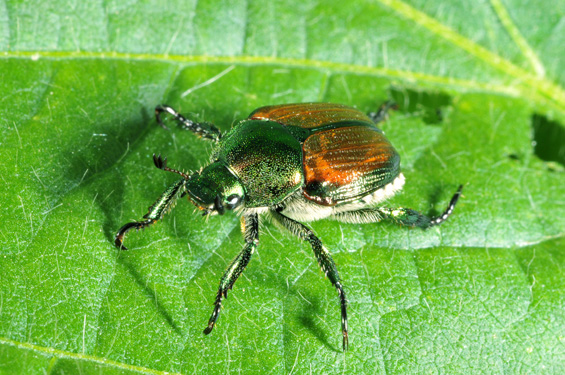
Common Name: Japanese beetle
Scientific Name: Scarabaeidae: Popillia japonica
Status: A pest of many plants, grasses and ornamentals
Damaging Stage: Adult and grub
Biology: The Japanese beetle is about �-inch long with shiny copper-colored wing covers and a shiny green top of the thorax and head. The abdomen has a row of white hair tufts of hair on each side. Adults emerge from the ground in mid-summer and the females deposit their eggs in the soil. The eggs hatch about two weeks after deposition, normally between July and August.
Japanese beetle larvae are "C"-shaped white grubs that live in the soil. They have a brown head capsule and three pairs of prolegs.
The larvae overwinter in cells beneath the soil surface. In the spring, the larvae move upward to complete feeding and to pupate. There is one generation per year.
Injury: Adult Japanese beetles may feed on over 400 different trees, shrubs, flowers, vegetables and crops. Their damage is usually to the leaves where they skeletonize the leave and render it of little value to the plant. Unlike the adults, Japanese beetle grub damage is primarily to grasses. Eggs are laid in the soil and when they hatch, the grubs prune the roots off of grasses including both turfgrass and corn. In areas of extensive feeding, the plant turns pale and resembles grass suffering from drought stress. This can kill the plant and in turfgrassses the turf can actually be lifted and rolled back like carpet.
Action Threshold: If plant leaves are decimated by adult feeding, control options should be considered. When sampling the soil, 6-8 Japanese beetle larvae recovered per square foot is considered the average action threshold for turfgrass.
Management: Japanese beetle adults and larvae can be managed by a number of biological and chemical controls. Extensive adult feeding usually requires chemical maintenance. Lawns that are well-managed can sustain higher larval populations than grass that is under environmental stress.
|